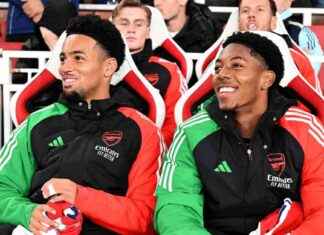The goal, stretched the Archer to the bowstring to the utmost, he will let the arrow loss chnellen. With rapid brush strokes in a deep dark blue, Karl Horst Hödicke take this Moment, where all the power is accumulated, to the point, in addition a couple of thin white lines that clarify the Essentials: the eye, the concentrated posture. Hödicke has a self-standing windshield and bow in the Studio, and some working day with a round of archery started. In order to be calm, to collect yourself and make a locker for always a new adventure with painting.
Because, as the dropped arrow, he allows the color of a Moment of freedom: “You set a color to the image, and then determines how it goes,” he says and continues: “I have always tried, this condition is not slowing down and paint.” The best way to show his “training runs”, as the artist calls consistently sporty a consequence of extremely large-format Works on paper, the left now for the first time his Studio to one of the strongest chapters on Hödicke-a retrospective in the Staatliche Graphische Sammlung München in the Pinakothek der Moderne to contribute. Its Director, Michael herring was allowed to select two thousand of these ideas a few dozen, the decision might not be easy to like.
Whether a snake Charmer, snowman and chimney sweep at the Hands of the artists loop with the new-born son, or “Only a scratch in the grey and red droplets” or a “Room”, flatly all of these sheets from the seventies and eighties, feature breathtaking dynamics and power of colour. And, not least, by the freedom with which the artists here, as in the whole plant in a between Figuration and Abstraction-wielding variety of styles vagabundiert.
In the case of Hödicke diving abstract motifs
abstract art was the name of the style of the hour, Karl Horst Hödicke was born in 1938 in Nürnberg, in Munich, grew up, and since 1957, lives in Berlin, began working there two years later, his painting studies at the Fred Thieler. Just as a restart after the Nazi art is celebrated and as a Follow on from the international, Modern, felt some of the young artists, the Maxim of abstraction as a Mode of inclination to the empty case. But when in Berlin painters such as Georg Baselitz, Eugen Schönebeck, Markus Lüpertz and Bernd Koberling and K. H. Hödicke with a new object of the rebellion, of course, does not discard the non-figurative, but rather include it as a component.
Hödickes painting “U-Bahn” from 1963, about the Details of the cars and stations with font elements and free gestural Brush strokes associated. As the young artist critically and ironically on the art of the time currents responsive, holds many a sheet of notebook-like “DIN-A4-drawings,” which runs the “Training” advance to go: As Tuschismus is under a red spot of water-colour on graph paper. Or “what can be said about Landart should know” under the Collage with the illustrated photo of a bombed-out jungle area. With crisp cherries will be nibbled in the case of Pop Art, and countless times with “Hödicke” piece of paper seems like a parody of Hanne Darboven’s conceptual writing drawings.
An abstract looking motif appears next to it in the Berlin space: There’s a lot of edgy contoured white surface turns out to be the view of a beautiful Berger backyard up in the sky, framed by the facade of the financial statements of the surrounding buildings. Berlin, the city he founded, together with Lüpertz is also one of the first producers of galleries, the legendary “großgörschen 35”, has observed Hödicke over the decades. Him the a long time, such as Scenes of half-destroyed look of the building, the Martin-Gropius-Bau, for example, that he saw from the window of his close to the wall of the nearby studios of fascinated. Many of the images he makes him look like “a Mirage in the urban desert”. The Berlin at night is portrayed, the lights, the “Rain Dance” on dripping wet cobblestones dancing, the colorful neon signs, loud fleeting impressions of the city and their silence in the snow.







